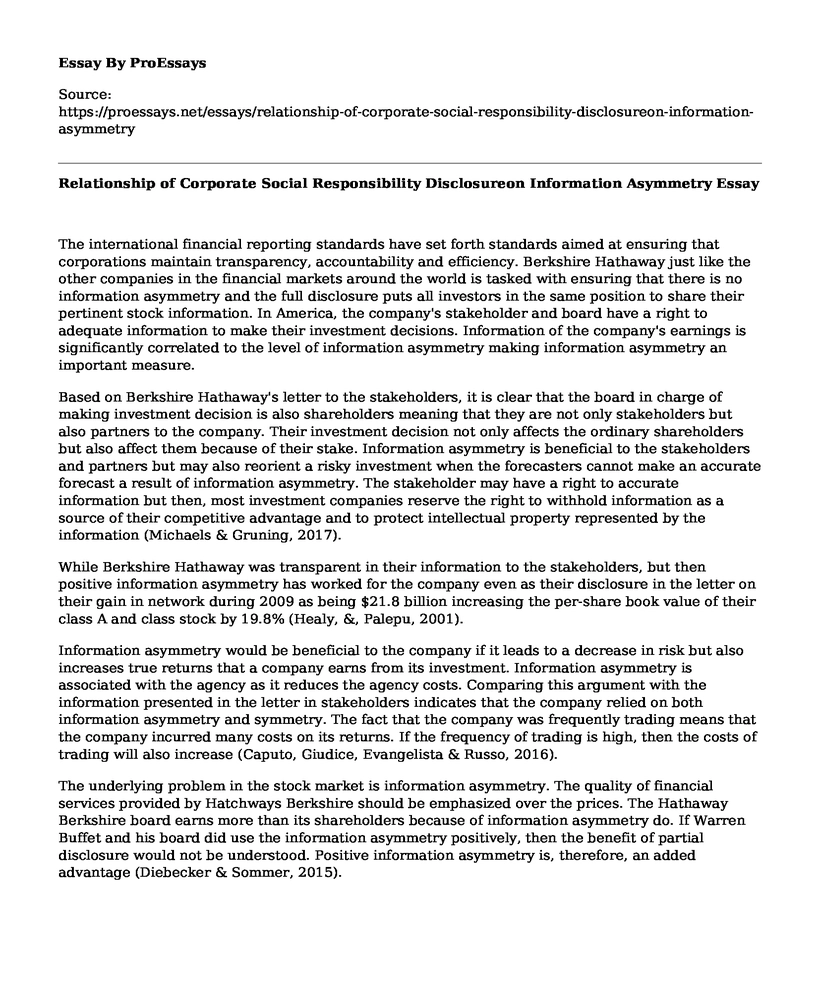The international financial reporting standards have set forth standards aimed at ensuring that corporations maintain transparency, accountability and efficiency. Berkshire Hathaway just like the other companies in the financial markets around the world is tasked with ensuring that there is no information asymmetry and the full disclosure puts all investors in the same position to share their pertinent stock information. In America, the company's stakeholder and board have a right to adequate information to make their investment decisions. Information of the company's earnings is significantly correlated to the level of information asymmetry making information asymmetry an important measure.
Based on Berkshire Hathaway's letter to the stakeholders, it is clear that the board in charge of making investment decision is also shareholders meaning that they are not only stakeholders but also partners to the company. Their investment decision not only affects the ordinary shareholders but also affect them because of their stake. Information asymmetry is beneficial to the stakeholders and partners but may also reorient a risky investment when the forecasters cannot make an accurate forecast a result of information asymmetry. The stakeholder may have a right to accurate information but then, most investment companies reserve the right to withhold information as a source of their competitive advantage and to protect intellectual property represented by the information (Michaels & Gruning, 2017).
While Berkshire Hathaway was transparent in their information to the stakeholders, but then positive information asymmetry has worked for the company even as their disclosure in the letter on their gain in network during 2009 as being $21.8 billion increasing the per-share book value of their class A and class stock by 19.8% (Healy, &, Palepu, 2001).
Information asymmetry would be beneficial to the company if it leads to a decrease in risk but also increases true returns that a company earns from its investment. Information asymmetry is associated with the agency as it reduces the agency costs. Comparing this argument with the information presented in the letter in stakeholders indicates that the company relied on both information asymmetry and symmetry. The fact that the company was frequently trading means that the company incurred many costs on its returns. If the frequency of trading is high, then the costs of trading will also increase (Caputo, Giudice, Evangelista & Russo, 2016).
The underlying problem in the stock market is information asymmetry. The quality of financial services provided by Hatchways Berkshire should be emphasized over the prices. The Hathaway Berkshire board earns more than its shareholders because of information asymmetry do. If Warren Buffet and his board did use the information asymmetry positively, then the benefit of partial disclosure would not be understood. Positive information asymmetry is, therefore, an added advantage (Diebecker & Sommer, 2015).
Conclusion
In conclusion, all corporations should comply with the standards set for by the IFRS. Information asymmetry may be a breach of the IFRS. Companies use information asymmetry to meet the financial obligation to the investors. Firms such as Hathaway Berkshire engaged in a confidential filing of portfolio holding to keep their investment under warp. If a company such as Hathaway Berkshire used the confidential holdings of information sensitive dealings such as mergers and acquisitions. Hathaway, Berkshires subjected its stocks to information asymmetry for the benefits of it stakeholders because confidential holdings provided much more risk-adjusted performance. In the process, the management inched private information. By failing to reveal their position in relation to stock, the company protected their intellectual properly by liquidation their position. Information asymmetry also allows the management to delay any disclosure as they wait for complete disposition.
References
Healy, P. and Palepu, K. (2001). "Information Asymmetry, Corporate Disclosure, and the Capital Markets: A Review of the Empirical Disclosure Literature", Journal of Accounting and Economics, 31, pp. 404-440.
Caputo, F., Giudice, M., Evangelista, F., & Russo, G. (2016). Corporate disclosure andintellectual capital: the light side of information asymmetry. International Journal Of Managerial And Financial Accounting, 8(1), 75. doi: 10.1504/ijmfa.2016.076668
Diebecker, J., & Sommer, F. (2015). The Impact of Corporate Sustainability Performance on Information Asymmetry in European Capital Markets. SSRN Electronic Journal. doi: 10.2139/ssrn.2555673
Michaels, A., & Gruning, M. (2017). Relationship of corporate social responsibility disclosureon information asymmetry and the cost of capital. Journal Of Management Control, 28(3), 251-274. doi: 10.1007/s00187-017-0251-z
WELKER, M. (1995). Disclosure Policy, Information Asymmetry, and Liquidity in Equity Markets. Contemporary Accounting Research, 11(2), 801-827. doi: 10.1111/j.1911-3846.1995.tb00467.x
Cite this page
Relationship of Corporate Social Responsibility Disclosureon Information Asymmetry. (2022, May 26). Retrieved from https://proessays.net/essays/relationship-of-corporate-social-responsibility-disclosureon-information-asymmetry
If you are the original author of this essay and no longer wish to have it published on the ProEssays website, please click below to request its removal:
- Corporate Social Responsibility of Noor Majan Research Paper Example
- Legal Implications: Unpaid Internship for International Students Essay
- Article Analysis Essay on New Trends in the Recruitment of Employees in Czech ICT Organizations
- Essay Sample on Law Enforcement
- Essay Sample on Bankruptcy Risks
- Planning For Your Future - Essay Sample
- Essay Sample on 2020 Rhodes Budget: Investing in Education & Basic Services







